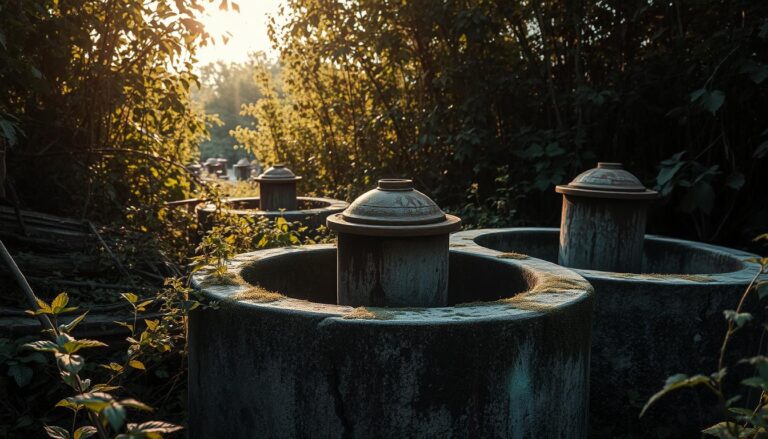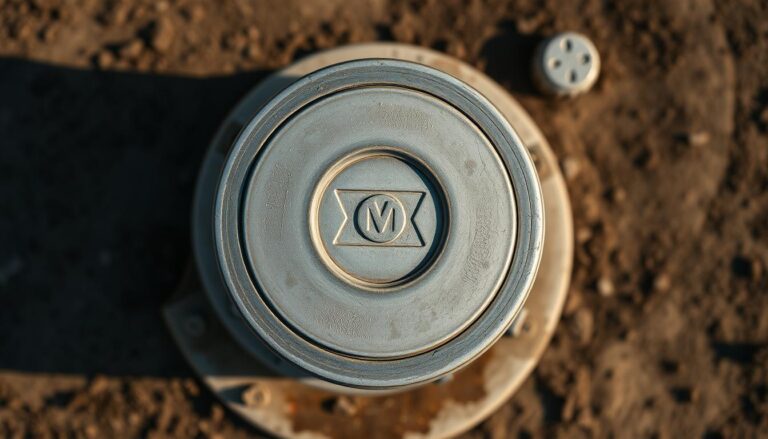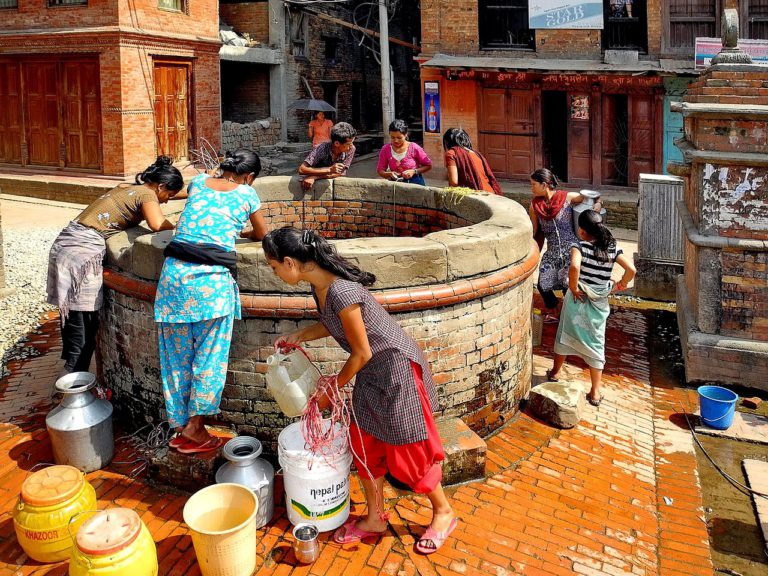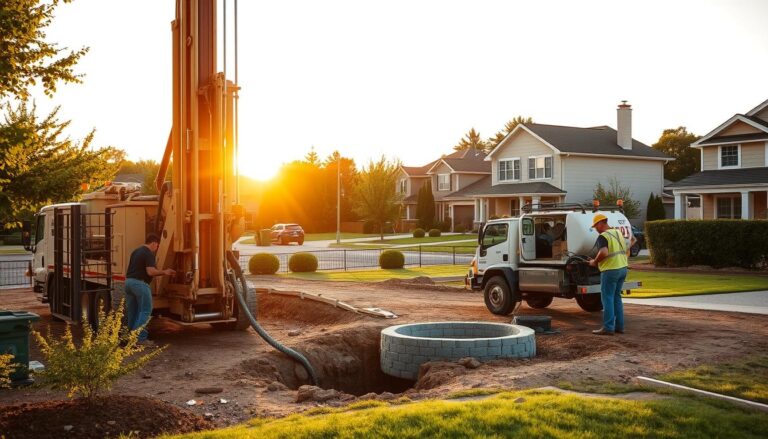Well Maintenance 101: Protect Your Water Supply Easily
For many homeowners, a private well is a vital source of water. However, maintaining it can be a daunting task. Ensuring your well is properly maintained is crucial for the health and safety of your family.
Regular maintenance helps prevent contamination and ensures the water quality remains high. Simple tasks, such as inspecting the well casing and checking the water level, can make a significant difference. By following private well maintenance tips, you can avoid costly repairs and ensure a steady supply of clean water.
Key Takeaways
- Regular inspection is crucial for well maintenance.
- Proper sealing prevents contamination.
- Monitoring water levels is essential.
- Testing water quality regularly is vital.
- Maintenance tasks can prevent costly repairs.
Understanding Your Private Well System
Understanding the components of your private well system is crucial for effective maintenance. A private well system is a complex network that requires regular upkeep to ensure the water remains safe and clean.
Common Types of Private Wells
There are several types of private wells, each with its unique characteristics. These include:
- Drilled Wells: These are the most common type, drilled deep into the ground to access water.
- Dug Wells: Dug wells are shallower and often less expensive to construct.
- Driven Wells: Driven wells involve driving a pipe into the ground to access water.
Key Components of a Well System
A well system consists of several key components, including:
- Well Casing and Cap: Protects the well from contamination.
- Pump and Pressure Tank: Delivers water from the well to the household.
- Water Lines and Electrical Components: Distributes water throughout the home.
How Your Well Water Reaches Your Home
The process begins with the well pump, which sends water to the pressure tank. From there, it is distributed through water lines to various parts of the home. For more detailed information on maintaining your private well, refer to the manual to protect private wells.
The Importance of Regular Well Maintenance
Regular well maintenance is crucial for ensuring the health and safety of your family. A well-maintained well provides clean water, free from contaminants that can cause serious health issues.
Protecting Your Family’s Health
Contaminated well water can lead to various health problems, including gastrointestinal issues and more severe conditions. Regular testing and maintenance help identify potential issues before they become major problems.
Extending the Lifespan of Your Well
Proper maintenance can significantly extend the life of your well. Regular inspections and timely repairs prevent minor issues from escalating into major problems that could shorten the well’s lifespan.
Preventing Costly Repairs
Regular maintenance is more cost-effective than dealing with major repairs. By addressing issues early, you can avoid expensive fixes down the line.
Maintaining Property Value
A well-maintained well contributes to the overall value of your property. Potential buyers are more attracted to homes with reliable, well-maintained water sources.
Essential Tools and Resources for Well Owners
To keep your well in top condition, it’s essential to have access to the necessary tools and information. Effective well maintenance involves a combination of the right equipment, proper record-keeping, and knowledge of professional resources.
Must-Have Maintenance Tools
Well owners should have a basic set of tools to perform routine maintenance tasks. These include a well pit cover key, a pipe wrench, and a volt-ohm meter for checking electrical systems. Having these tools on hand can help identify and fix issues before they become major problems.
Record-Keeping Systems
Maintaining detailed records is crucial for well owners. This includes:
Well Construction Records
These records provide details about the well’s construction, including its depth, casing material, and screen type.
Maintenance Logs
Keeping a log of all maintenance activities helps track the well’s performance over time and identify recurring issues.
Water Test Results
Regular water testing is essential for ensuring the water quality. Keeping records of test results helps monitor changes in water quality.
| Record Type | Description | Importance |
|---|---|---|
| Well Construction Records | Details about the well’s construction | Essential for understanding the well’s design and potential vulnerabilities |
| Maintenance Logs | Log of all maintenance activities | Helps track performance and identify recurring issues |
| Water Test Results | Records of water quality tests | Crucial for ensuring water safety and monitoring changes in quality |
“Proper record-keeping is the backbone of effective well maintenance. It ensures that well owners can make informed decisions about their well’s care.”
Professional Resources and Contacts
Well owners should also be aware of professional resources available to them. This includes local well contractors, water testing laboratories, and regulatory agencies. Having these contacts can be invaluable in case of emergencies or when seeking advice on well maintenance.
By having the right tools, maintaining accurate records, and knowing where to find professional help, well owners can ensure their well remains a safe and reliable source of water.
Creating a Well Maintenance Schedule
Establishing a regular maintenance schedule is crucial for the longevity and safety of your private well. A well-maintained private well not only ensures the quality of your water supply but also protects your family’s health and prolongs the lifespan of your well system.
Monthly Maintenance Tasks
Regular monthly checks are vital to identify potential issues early. These tasks include:
- Inspecting the well casing and surrounding area for signs of damage or contamination
- Checking the well cap to ensure it’s secure and undamaged
- Monitoring water pressure and flow rate
By performing these monthly tasks, you can catch problems before they become major issues, following essential private well maintenance tips.
Seasonal Maintenance Considerations
Different seasons bring unique challenges for your private well. Understanding these seasonal factors can help you prepare and maintain your well effectively.
Spring Preparation
In the spring, inspect your well and surrounding area for damage caused by winter weather. Check for any debris or sediment that may have accumulated around the wellhead.
Summer Monitoring
During the summer, monitor your well’s water level and pressure more frequently, especially during periods of drought or heavy water usage.
Fall Winterization
As fall approaches, prepare your well for the upcoming winter by checking the well casing and pipes for any signs of damage or wear. Consider having a professional inspect your well system.
Winter Protection
In colder climates, protect your well from freezing temperatures by insulating exposed pipes and ensuring the well cap is securely tightened.
Annual Professional Inspections
While regular monthly and seasonal checks are important, an annual professional inspection is crucial for a comprehensive assessment of your well’s condition. A professional can perform detailed well water testing and identify potential issues that may not be apparent during routine checks.
How to Maintain a Private Well: Step-by-Step Guide
To keep your private well functioning effectively, it’s necessary to follow a comprehensive maintenance routine. This involves several key steps that help ensure your well provides safe and clean water for your household.
Visual Inspection Procedures
Regular visual inspections are crucial for identifying potential issues before they become major problems. Start by checking the well cap and seal for any signs of damage or wear.
Checking the Well Cap and Seal
Ensure the well cap is securely locked and the seal is intact. Any damage or gaps can allow contaminants to enter the well. For more information on proper well construction and maintenance, you can visit the El Dorado County Water Well Program website.
Inspecting the Well Casing
Inspect the well casing for cracks, rust, or other signs of deterioration. The casing should be intact to prevent surface water from seeping into the well.
Examining Surrounding Areas
Check the area around the well for potential contamination sources, such as nearby septic systems or agricultural runoff. Keeping this area clear of hazards is essential for maintaining water quality.
Water Testing Protocols
Regular water testing is vital for ensuring the water from your private well is safe to drink. Test for bacteria, nitrates, and other contaminants that can pose health risks.
System Component Maintenance
Maintaining the components of your well system is crucial for its overall performance. This includes the pressure tank and filtration system.
Pressure Tank Care
The pressure tank should be inspected regularly for signs of wear or malfunction. Proper pressure tank function is essential for maintaining consistent water pressure throughout your home.
Filtration System Upkeep
Regularly check and maintain your filtration system to ensure it’s effectively removing contaminants from your water. Replace filters as recommended by the manufacturer.
By following these steps and maintaining a regular maintenance schedule, you can ensure your private well continues to provide safe and clean water for years to come.
Well Water Testing: What, When, and How
Regular well water testing is a vital step in maintaining a safe and reliable source of drinking water. Testing your well water helps identify potential contaminants that could pose health risks to you and your family.
Essential Contaminants to Test For
When testing your well water, it’s crucial to check for a variety of contaminants. These include:
Bacteria and Pathogens
E. coli and other bacteria can contaminate well water, causing serious health issues. Testing for these pathogens is essential to ensure your water is safe to drink.
Nitrates and Chemicals
Nitrates from agricultural runoff or sewage can be particularly harmful to infants and pregnant women. Testing for nitrates and other chemicals is vital.
Heavy Metals
Heavy metals like lead and arsenic can enter your well water through natural or human-induced sources. Regular testing helps detect these contaminants.
DIY Testing vs. Professional Laboratory Testing
While DIY testing kits are available, they may not provide comprehensive results. Professional laboratory testing offers more accurate and detailed analysis of your well water quality.
Interpreting Your Water Test Results
Understanding your water test results is crucial. Look for levels of contaminants that exceed safety standards. If you find any, consider treatment options or consult a water quality expert.
Recommended Testing Frequency
It’s generally recommended to test your well water at least once a year. However, factors like nearby agricultural activities or changes in water taste or odor may necessitate more frequent testing.
| Contaminant | Potential Source | Health Risk |
|---|---|---|
| Bacteria (e.g., E. coli) | Surface contamination, sewage | Gastrointestinal illness |
| Nitrates | Agricultural runoff, sewage | Blue baby syndrome, cancer risk |
| Heavy Metals (e.g., Lead, Arsenic) | Natural occurrence, industrial pollution | Neurological damage, cancer |

Well Pump Maintenance and Care
A well-functioning well pump is the heart of your private well, ensuring a steady water supply. Proper maintenance of your well pump is essential to prevent failures and ensure the longevity of your well system.
Signs of Pump Problems
Identifying potential issues early can save you from costly repairs. Look out for signs such as reduced water pressure, unusual noises, or increased energy consumption. If you notice any of these symptoms, it may indicate a problem with your well pump.
Routine Pump Maintenance Steps
Regular maintenance is key to extending the life of your well pump. Here are some steps you can take:
Checking for Unusual Noises
Unusual noises can be an early indicator of pump problems. Listen for grinding, screeching, or other abnormal sounds coming from the pump.
Monitoring Pressure Levels
Ensure that your well pump is maintaining the correct pressure levels. Low pressure can indicate a problem with the pump or the system.
Inspecting Electrical Connections
Check the electrical connections to your well pump regularly. Corrosion or damage to these connections can lead to pump failure.
| Maintenance Task | Frequency | Importance Level |
|---|---|---|
| Check for Unusual Noises | Monthly | High |
| Monitor Pressure Levels | Weekly | High |
| Inspect Electrical Connections | Quarterly | Medium |
When to Replace Your Well Pump
Knowing when to replace your well pump is crucial. If your pump is old, inefficient, or frequently malfunctioning, it may be time to consider a replacement. Consult a professional to assess the condition of your well pump and recommend the best course of action.
Water Treatment Options for Private Wells
Water treatment is a crucial aspect of private well maintenance, impacting both the health and comfort of households. Private well owners often encounter various water quality issues that necessitate effective treatment solutions.
Common Water Quality Issues
Private wells can be susceptible to several water quality problems. These include:
- Hardness and mineral content issues
- Acidity and pH imbalances
- Sulfur and iron problems
Hardness and Mineral Content
High levels of minerals such as calcium and magnesium can cause water hardness, leading to scale buildup in pipes and appliances. Treatment options include water softeners that remove these minerals.
Acidity and pH Imbalances
Acidic water can corrode pipes, releasing harmful metals into the water. pH adjustment systems can help balance the water’s acidity.
Sulfur and Iron Problems
Water with high sulfur or iron content can have unpleasant odors and tastes. Specialized filters can remove these contaminants, improving the water’s quality.
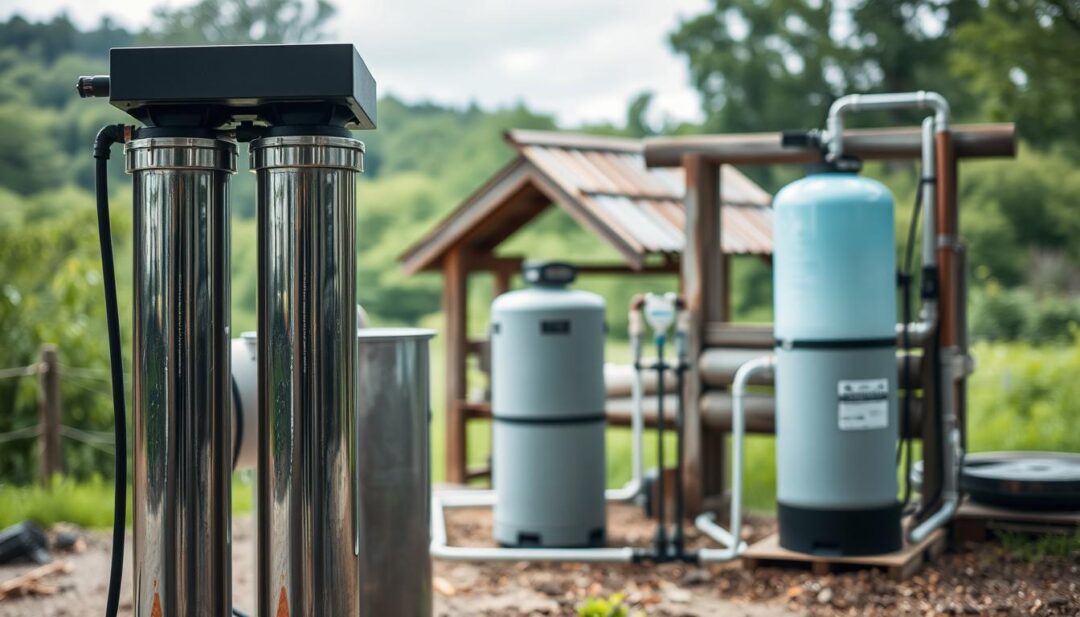
Types of Water Treatment Systems
Various water treatment systems are available to address different water quality issues. These include:
- Activated carbon filters for removing chlorine and improving taste
- Reverse osmosis systems for comprehensive contaminant removal
- UV disinfection systems for killing bacteria and viruses
For more information on determining if your well is going dry, which can also impact water quality, visit How to Tell if Your Water Well is Going.
Maintaining Your Water Treatment Equipment
Regular maintenance of water treatment equipment is essential to ensure its effectiveness. This includes replacing filters, checking system performance, and sanitizing components periodically.
Protecting Your Well from Environmental Factors
The integrity of your private well can be compromised by various environmental factors, making it essential to take protective measures.
Landscaping Considerations Around Wells
When landscaping around your well, it’s crucial to avoid planting trees or shrubs too close, as their roots can potentially damage the well casing or cap. Maintain a safe distance to prevent such issues.
Managing Potential Contamination Sources
Several environmental factors can contaminate your well water. Understanding and managing these risks is vital.
Septic Systems
Ensure your septic system is functioning correctly and is at a safe distance from your well to prevent bacterial contamination.
Agricultural Activities
If you live near agricultural land, be aware of the potential for chemical runoff into your well. Regular water testing can help identify any issues early.
Chemical Storage
Store chemicals and fuels in a secure, well-ventilated area away from your well to prevent accidental contamination.
Flood and Storm Preparation
Floods and storms can pose significant risks to your well’s integrity. Take steps to secure your wellhead and consider emergency preparedness plans.
Well Water Conservation Practices
Conserving well water not only saves this valuable resource but also reduces the strain on your well system. Implementing water-efficient appliances and practices can make a significant difference.
| Environmental Factor | Risk | Protective Measure |
|---|---|---|
| Septic Systems | Bacterial Contamination | Regular Inspection and Maintenance |
| Agricultural Activities | Chemical Runoff | Regular Water Testing |
| Chemical Storage | Accidental Contamination | Secure Storage Practices |
As a private well owner, staying informed and proactive is key to protecting your water supply. By understanding and mitigating environmental risks, you can ensure the long-term quality and safety of your well water.
Conclusion: Ensuring Your Well’s Longevity
Maintaining a private well is crucial for ensuring a safe and reliable source of clean water. By understanding the importance of well maintenance and following the steps outlined in this guide, you can help extend the life of your well and protect your family’s health.
Regular maintenance tasks, such as visual inspections, water testing, and system component maintenance, are essential for identifying potential issues before they become major problems. By staying on top of these tasks, you can prevent costly repairs and ensure your well continues to provide clean water for years to come.
To maintain a private well effectively, it’s essential to be proactive. Create a maintenance schedule, keep accurate records, and stay informed about potential environmental factors that could impact your well’s water quality. By taking these steps, you can enjoy peace of mind knowing your well is well-maintained and functioning properly.
By prioritizing the importance of well maintenance and taking a proactive approach to how to maintain a private well, you can safeguard your water supply and protect your investment.


